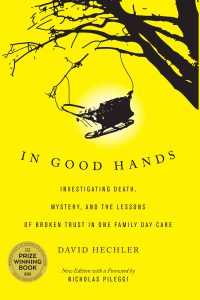Prologue
From In Good Hands by David Hechler
 Every week millions of children in the United States attend day care. How do parents know that their children are safe?
Every week millions of children in the United States attend day care. How do parents know that their children are safe?
The dangers were underscored by a series of articles in the Minneapolis Star Tribune on day care safety that won a Pulitzer Prize in 2013. The reporters found that dozens of Minnesota children died in day care during the previous five years—nearly all of them in home-based settings. The newspaper also noted that state regulators weren’t in a position to prevent these deaths. In fact, they weren’t even aware that these numbers represented an alarming jump from previous years.
The key for parents is to recognize two things. The government is not monitoring day care. Parents have to undertake this job themselves. And second, parents are in a much better position to judge a day care after they select it than they were when they were choosing one. Many assume that the big task is interviewing caregivers and picking one. But afterward is when the real work should begin.
This book focuses on a true story about one day care that parents thought was exceptional. It was neat and clean, and the caregivers were a married, middle-class couple who were active in their church and had three kids of their own. The setting was a suburb outside of Columbia, South Carolina. The mothers who dropped off their children every morning were mostly in their early thirties. Many of them were college graduates, and they worked in a variety of fields. They all visited the day care before they chose it. Many of them had visited several others before they’d settled on this one.
There was nothing about the woman who ran it that alarmed them. On the contrary, she seemed sweet and dedicated, if a little reserved. Not the type of person you expect to stand trial for murder. But she did.
Many people in her community were convinced that the prosecutors who targeted her were completely off base. Among her strongest supporters were some of the parents who sent their children to her home—and stopped doing so only when the state shut it down.
The purpose of this book isn’t merely to recount an intriguing mystery, even though it featured plot twists worthy of the best fiction. (In this respect, it may remind some readers of the popular podcast “Serial,” which also brought to life an old murder case that had never been fully explored.) And the point is not merely to pass along a few tips on day care. It’s to convince parents and grandparents that no one else will monitor the safety of their children, and to arm them with the knowledge to do the job themselves.
Finally, the Appendix at the end of this book features interviews with two experts who offer a wealth of practical advice. The second expert also notes that the lessons learned, and the skills acquired, from focusing on day care can pay huge dividends later in life, when you may be looking for a nursing home, or an assisted living facility, or a rehab center for your own parents.
Copyright © 2016 David Hechler
